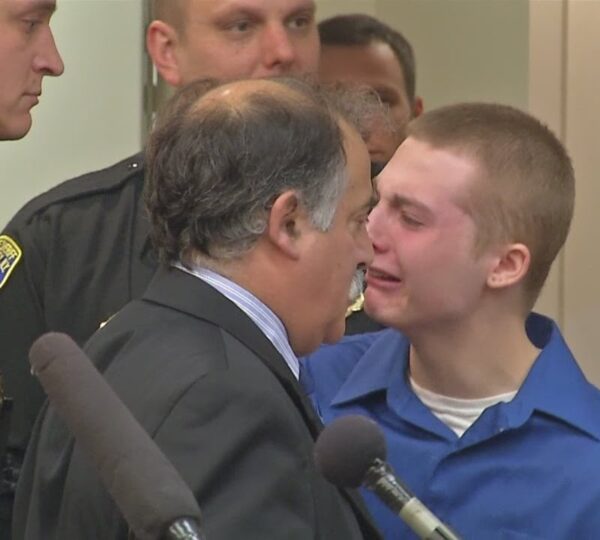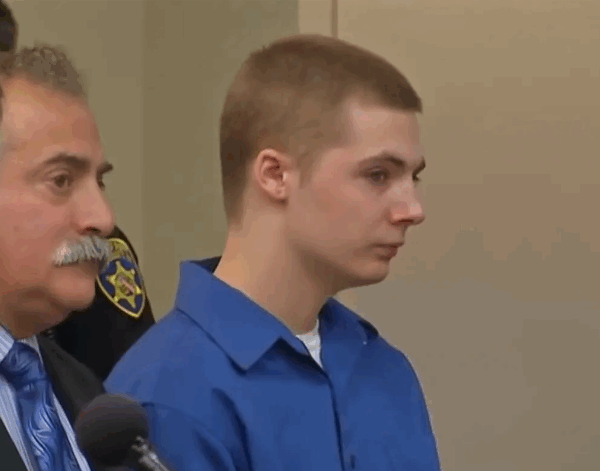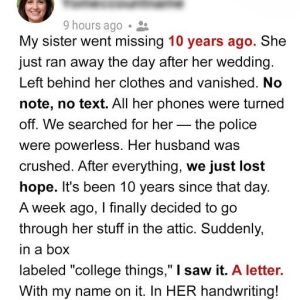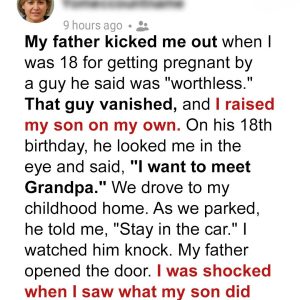Long before the gavel fell, whispers of an extraordinary punishment rippled through the courtroom. Few could imagine the scale of what was about to happen. When the judge finally spoke, the verdict left everyone in shock: a staggering 985 years behind bars for a teenager barely old enough to drive.
The sentence seemed almost unimaginable, stretching beyond the span of a human lifetime and eclipsing the potential of entire generations. Many in the courtroom struggled to comprehend what they were hearing. What could possibly justify such an extreme punishment? And what message was the justice system trying to send?
Inside the courtroom, disbelief hung thick in the air. The teenager, whose identity remains confidential due to age, stood silently as the judge read aloud the verdict. Witnesses described the scene as surreal. Murmurs of shock and outrage rippled across the room, punctuated by audible gasps.

Video footage from the trial captures the teen’s face, shifting from confusion to outright horror. In that instant, his future seemed effectively erased, leaving a chilling sense of finality. The sentencing came after a lengthy trial that revealed a troubling pattern of violent and reckless behavior, painting a complex and unsettling picture of the defendant.
Prosecutors presented a harrowing account of the crimes. They detailed a series of assaults, robberies, and other reckless actions that left the local community reeling. According to court records, the number and severity of the charges made this case one of the most complex and challenging the courts had ever handled.
While some details remain sealed to protect the teenager’s identity, officials emphasized that the extraordinary magnitude of his crimes warranted an unprecedented ruling. The courtroom remained tense as every detail of the case was laid bare, highlighting the legal system’s struggle with extreme situations involving minors.
As news of the sentencing spread, social media erupted. Video clips of the courtroom reactions quickly went viral, sparking fierce debates. Millions of viewers weighed in online, sharing a wide spectrum of opinions. Some criticized the ruling as cruel and inhumane, arguing that no teenager should be completely written off, regardless of their actions.
Others defended the court’s decision, insisting that justice requires accountability, even for young offenders. The polarized reactions reflect a deeper societal debate over the limits of punishment, justice, and the potential for rehabilitation in the lives of youthful offenders.

The 985-year sentence has become more than a local news story; it is now a global flashpoint in conversations about justice, morality, and the law. It raises urgent questions: Can society justify condemning a young life without hope for reform?
Should the legal system place greater emphasis on rehabilitation, or is there a point where accountability requires permanent consequences? The case forces communities to confront their own definitions of fairness and justice, reminding the public that the law is often more complicated than it appears.
Legal experts have weighed in, offering perspectives on the implications of such extreme sentencing. Many point out that, while symbolic in nature, a sentence of this length is effectively a life sentence multiple times over. Others argue it reflects society’s frustration and desire to deter future criminal behavior.
Psychologists emphasize the importance of understanding the developmental stage of young offenders, raising questions about whether a teenager can fully comprehend the consequences of their actions.
Community members who were affected by the teen’s actions also voiced their reactions. Some expressed relief that justice had been served, hoping that the sentence would prevent further harm.
Others, however, expressed concern about the potential for long-term psychological impact on the offender and whether society should focus more on rehabilitation programs for troubled youth. These mixed reactions underscore the complexity of balancing justice with compassion.
The courtroom reaction itself became a viral moment. As the sentence was announced, gasps and murmurs of disbelief spread among family members, journalists, and legal observers. The teen remained silent, processing the gravity of the verdict, while attorneys and court staff struggled to maintain order.
Outside the courtroom, reporters captured the emotional intensity of the moment, highlighting the broader societal implications of extreme juvenile sentencing.
Across the globe, commentators, journalists, and legal analysts debated the case’s significance. Headlines ranged from shock and outrage to philosophical reflections on justice. Some social media users created discussion threads asking whether laws governing juvenile offenders need reform.
Others shared stories of rehabilitation, questioning whether the justice system missed opportunities to guide the teen toward a productive future. The discourse continues to spark conversations about the intersection of law, morality, and human development.
Ultimately, this case is not only a legal story but a reflection of society’s struggle to reconcile justice with the potential for redemption. It raises fundamental questions about how communities respond to youth crime and what values are prioritized in the judicial process.
Can a system designed to punish truly offer pathways for change? Or does society sometimes demand punishment so extreme that hope is extinguished? These questions linger long after the gavel has fallen, leaving both legal experts and the general public to wrestle with the meaning of justice in extreme cases.
Long before the gavel fell, whispers of an extraordinary punishment rippled through the courtroom. Few could imagine the scale of what was about to happen. When the judge finally spoke, the verdict left everyone in shock: a staggering 985 years behind bars for a teenager barely old enough to drive.
The sentence seemed almost unimaginable, stretching beyond the span of a human lifetime and eclipsing the potential of entire generations. Many in the courtroom struggled to comprehend what they were hearing. What could possibly justify such an extreme punishment? And what message was the justice system trying to send?
Inside the courtroom, disbelief hung thick in the air. The teenager, whose identity remains confidential due to age, stood silently as the judge read aloud the verdict. Witnesses described the scene as surreal. Murmurs of shock and outrage rippled across the room, punctuated by audible gasps.

Video footage from the trial captures the teen’s face, shifting from confusion to outright horror. In that instant, his future seemed effectively erased, leaving a chilling sense of finality. The sentencing came after a lengthy trial that revealed a troubling pattern of violent and reckless behavior, painting a complex and unsettling picture of the defendant.
Prosecutors presented a harrowing account of the crimes. They detailed a series of assaults, robberies, and other reckless actions that left the local community reeling. According to court records, the number and severity of the charges made this case one of the most complex and challenging the courts had ever handled.
While some details remain sealed to protect the teenager’s identity, officials emphasized that the extraordinary magnitude of his crimes warranted an unprecedented ruling. The courtroom remained tense as every detail of the case was laid bare, highlighting the legal system’s struggle with extreme situations involving minors.
As news of the sentencing spread, social media erupted. Video clips of the courtroom reactions quickly went viral, sparking fierce debates. Millions of viewers weighed in online, sharing a wide spectrum of opinions. Some criticized the ruling as cruel and inhumane, arguing that no teenager should be completely written off, regardless of their actions.
Others defended the court’s decision, insisting that justice requires accountability, even for young offenders. The polarized reactions reflect a deeper societal debate over the limits of punishment, justice, and the potential for rehabilitation in the lives of youthful offenders.

The 985-year sentence has become more than a local news story; it is now a global flashpoint in conversations about justice, morality, and the law. It raises urgent questions: Can society justify condemning a young life without hope for reform?
Should the legal system place greater emphasis on rehabilitation, or is there a point where accountability requires permanent consequences? The case forces communities to confront their own definitions of fairness and justice, reminding the public that the law is often more complicated than it appears.
Legal experts have weighed in, offering perspectives on the implications of such extreme sentencing. Many point out that, while symbolic in nature, a sentence of this length is effectively a life sentence multiple times over. Others argue it reflects society’s frustration and desire to deter future criminal behavior.
Psychologists emphasize the importance of understanding the developmental stage of young offenders, raising questions about whether a teenager can fully comprehend the consequences of their actions.
Community members who were affected by the teen’s actions also voiced their reactions. Some expressed relief that justice had been served, hoping that the sentence would prevent further harm.
Others, however, expressed concern about the potential for long-term psychological impact on the offender and whether society should focus more on rehabilitation programs for troubled youth. These mixed reactions underscore the complexity of balancing justice with compassion.
The courtroom reaction itself became a viral moment. As the sentence was announced, gasps and murmurs of disbelief spread among family members, journalists, and legal observers. The teen remained silent, processing the gravity of the verdict, while attorneys and court staff struggled to maintain order.
Outside the courtroom, reporters captured the emotional intensity of the moment, highlighting the broader societal implications of extreme juvenile sentencing.
Across the globe, commentators, journalists, and legal analysts debated the case’s significance. Headlines ranged from shock and outrage to philosophical reflections on justice. Some social media users created discussion threads asking whether laws governing juvenile offenders need reform.
Others shared stories of rehabilitation, questioning whether the justice system missed opportunities to guide the teen toward a productive future. The discourse continues to spark conversations about the intersection of law, morality, and human development.
Ultimately, this case is not only a legal story but a reflection of society’s struggle to reconcile justice with the potential for redemption. It raises fundamental questions about how communities respond to youth crime and what values are prioritized in the judicial process.
Can a system designed to punish truly offer pathways for change? Or does society sometimes demand punishment so extreme that hope is extinguished? These questions linger long after the gavel has fallen, leaving both legal experts and the general public to wrestle with the meaning of justice in extreme cases.





